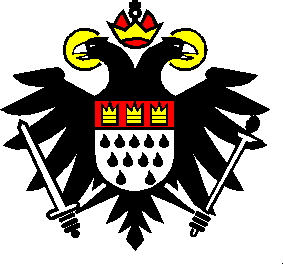

The Cologne coat of arms shows the two-headed Imperial eagle holding sword and sceptre. This is in commemoration of Cologne having officially become a free imperial city of the Holy Roman Empire of the German Nation in 1475. The eagle has two heads because the Roman emperor also was the German king. The coat of arms bears the colours red and white as these are the colours of the Hanseatic League. As an important commercial metropolis Cologne was not only a member of this federation of merchants and cities but it even was - just like Lubeck - one of the founding members of the League and therefore is one of the oldest Hanseatic cities.
The three crowns have been an emblem of Cologne since the 12th century, because in 1164 Emperor Frederick Barbarossa defeated Milan and gave the relics of the Magi as booty to the Cologne archbishop Reinald von Dassel, his faithful chancellor, who then brought them to Cologne. These relics are still being kept inside a golden shrine behind the high altar in Colgne Cathedral. On account of its many and important relics Cologne was considered a sacred city in the Middle Ages and proudly called itself Sancta Colonia.
The eleven black drops (or flames) stand for our patron saint Ursula, who was extremely popular then. They have been represented in the coat of arms since the 16th century. According to the legend St. Ursula was a princess from Brittany. On her way back from a pilgrimage to Rome she and her companions were murdered by Attila the Hun, who at that time had been besieging Cologne. Thus 11,000 virgins died here as martyrs! The eleven "drops" in our coat of arms are actually neither drops nor flames, but the black tips of the tails of ermines on white ermine fur because the coat of arms of Brittany was made of ermine fur.
© Yvonne Plum 2006
